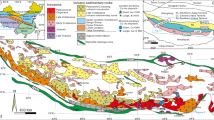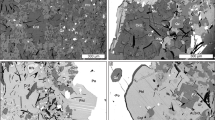Abstract
The mineralogical, elemental, and isotopic characteristics of a hydrothermal sulfide sample from one dredge station (12°42.30′N, 103°54.48′W, water depth 2655 m) on the East Pacific Rise near 13°N were analyzed. The hydrothermal sulfide was composed mainly of sphalerite, chalcopyrite, and pyrite and was a Zn-rich sulfide; in layer ep-s-1, goethite formed by secondary oxidation was found. The concentrations of rare elements, such as Li (0.15×10−6–0.30×10−6), Be (0.01×10−6–0.05×10−6), Zr (73.8×10−9–1344×10−9), Nb (8.14×10−9–64.7×10−9), Hf (2.54×10−9–28.0×10−9), and Ta (0.203×10−9–1.21×10−9), were far lower in the hydrothermal sulfide than in the ocean crust, whereas the content of Au was higher and the contents of Co, Ni, Sr, Cs, Ba, Bi, and U were low. The correlations between Zn and Cr, Cd and Ga, Cu and P, P and In (R 2 > 0.8) were positive, whereas those between Zn and Fe, Cu, and Ba (R 2 > 0.8) were distinctly negative. From low-temperature mineral assemblages to high-temperature mineral assemblages, the spatial distributions of dispersive and rare elements (e.g. In, Li, Cs) in the hydrothermal sulfide displayed corresponding variations. The variations observed in some elements (e.g., Cd, Cs, P) are controlled by Zn, Fe, and Cu sulfides, respectively. Seafloor weathering accounts for the enrichment of V, Mn, and rare earth elements (REE) in the henna sulfide-oxidation layer that bears the secondary oxide mineral, leading to identical REE patterns for this layer (ep-s-1) and seawater. Seafloor weathering also distinctly affects the correlations between the element ratios of the hydrothermal sulfide. From high-temperature mineral assemblages to low-temperature mineral assemblages, Fe content and δ 34S value of the hydrothermal sulfide increase gradually, and Zn content and lead isotopic ratios decrease gradually on the contrary, which indicate the influences of seawater on elements and the sulfur and lead isotopic compositions enhance gradually during the formation of hydrothermal sulfides.
Similar content being viewed by others
References
Fouquet Y, Knott R, Cambon P, et al. Formation of large sulfide mineral deposits along fast spreading ridges. Example from off-axial deposits at 12°43′N on the East Pacific Rise. Earth Planet Sci Lett, 1996, 144: 147–162
Fouquet Y, Auclair G, Cambon P, et al. Geological setting and mineralogical and geochemical investigations on sulfide deposits near 13°N on the East Pacific Rise. Mar Geol, 1988, 84: 145–178
Lalou C, Brichet E, Hekinian R. Age dating of sulfide deposits from axial and off-axial structures on the East Pacific Rise near 12°50′N. Earth Planet Sci Lett, 1985, 75: 59–71
Auclair G, Fouquet Y, Bohn M. Distribution of selenium in high temperature hydrothermal sulfide deposits at 13 degree North, East Pacific Rise. Can Mineral, 1987, 25: 577–587
Fouquet Y, Marcoux E. Lead isotope systematics in Pacific hydrothermal sulfide deposits. J Geophys Res, 1995, 100: 6025–6040
Jean-Baptiste P, Fouquet Y. Abundance and isotopic composition of helium in hydrothermal sulfides from the East Pacific Rise at 13°N. Geochim Cosmochim Acta, 1996, 60: 87–93
Stuart F M, Turner G. Mantle-derived 40Ar in mid-ocean ridge hydrothermal fluids: Implications for the source of volatiles and mantle degassing rates. Chem Geol, 1998, 147: 77–88
Ono S, Shanks W C III, Rouxel O J, et al. S-33 constraints on the seawater sulfate contribution in modern seafloor hydrothermal vent sulfides. Geochim Cosmochim Acta, 2007, 71: 1170–1182
Zeng Z G, Wang X Y, Zhang G L, et al. Formation of Fe-oxyhydroxides from the East Pacific Rise near latitude 13°N: Evidence from mineralogical and geochemical data. Sci China Ser D-Earth Sci, 2008, 51: 206–215
Kuriyama T, Matsumoto K, Fujioka H. Polymetallic sulfides on the off-axis volcanoes around the East Pacific Rise, 11°30′N latitute. Resour Geol, 1994, 44: 187–199
Moss R, Scott S D. Silver in sulfide chimneys and mounds from 13°N and 21°N, East Pacific Rise. Can Mineral, 1996, 34: 697–716
Hekinian R, Fevrier M, Bischoff J L, et al. Sulfide deposits from the East Pacific Rise near 21°N. Science, 1980, 207: 1433–1444
Bischoff J L, Rosenbauer R J, Aruscavage P J, et al. Sea-floor massive sulfide deposits from 21°N, East Pacific Rise, Juan de Fuca Ridge, and Galapagos Rift: Bulk chemical composition and economic implications. Econ Geol, 1983, 78: 1711–1720
Zierenberg R A, Shanks W C III, Bischoff J L. Massive sulfide deposits at 21°, East Pacific Rise: Chemical composition, stable isotopes, and phase equilibria. Geol Soc Am Bull, 1984, 95: 922–929
Hannington M D, Herzig P M, Scott S D, et al. Comparative mineralogy and geochemistry of gold-bearing sulfide deposits on the mid-ocean ridges. Mar Geol, 1991, 101: 217–248
Barrett T J, Jarvis I, Jarvis K E. Rare-earth element geochemistry of massive sulfides-sulfates and gossans on the Southern Explorer Ridge. Geology, 1990, 18: 583–586
Bendel V, Fouquet Y, Auzende J M, et al. The White Lady hydrothermal field, North Fiji back-arc basin, Southwest Pacific. Econ Geol, 1993, 88: 2237–2249
Binns R A, Scott S D. Actively forming polymetallic sulfide deposits associated with felsic volcanic rocks in the eastern Manus back-arc basin, Papua New Guinea. Econ Geol, 1993, 88: 2226–2236
Halbach P, Blum N, Muench U, et al. Formation and decay of a modern massive sulfide deposit in the Indian Ocean. Miner Depos, 1998, 33: 302–309
Koski R A, Shanks W C III, Bohrson W A, et al. The composition of massive sulfide deposits from the sediment-covered floor of Escanaba Trough, Gorda Ridge: Implications for depositional processes. Can Mineral, 1988, 26: 655–673
Langmuir C, Humphris S, Fornari D, et al. Hydrothermal vents near a mantle hot spot, the Lucky Strike vent field at 37°N on the Mid-Atlantic Ridge. Earth Planet Sci Lett, 1997, 148: 69–91
Lisitsyn A P, Malahoff A R, Bogdanov Yu A, et al. Hydrothermal formations in the northern part of the Lau Basin, Pacific Ocean. Int Geol Rev, 1992, 34: 828–847
Marchig V, Blum N, Roonwal G. Massive sulfide chimneys from the East pacific Rise at 7°24′S and 16°34′S. Mar Geores Geothechnol, 1997, 15: 49–66
Mozgova N N, Efimov A V, Borodaev Y S, et al. Cobalt pentlandite from an oceanic hydrothermal deposit, 14°45′N, Mid-Atlantic Ridge. Can Mineral, 1996, 34: 23–28
Murphy P J, Meyer G. A gold-copper association in ultramafic-hosted hydrothermal sulfides from the Mid-Atlantic Ridge. Econ Geol, 1998, 93: 1076–1083
Petersen S, Herzig P, Hannington M. Third dimension of a presently forming VMS deposit, TAG hydrothermal mound, Mid-Atlantic Ridge, 26°N. Miner Depos, 2000, 35: 233–259
Taylor S R, McLennan S M. The Continental Crust: Its Composition and Evolution. Oxford: Blackwell, 1985. 312
Piepgras D J, Jacobsen S B. The behavior of rare earth elements in seawater: Precise determination of variations in the North Pacific water column. Geochim Cosmochim Acta, 1992, 56: 1851–1862
Douville E, Bienvenu P, Charlou J L, et al. Yttrium and rare earth elements in fluids from various deep-sea hydrothermal systems. Geochim Cosmochim Acta, 1999, 63: 627–643
Bluth G J, Ohmoto H. Sulfide-sulfate chimneys on the East Pacific Rise, 11°N and 13°N latitude. Part II: Sulfur isotopes. Can Mineral, 1988, 26: 505–515
Stuart F M, Duckworth R, Turner G, et al. Helium and sulfur isotopes in sulfides from the Middle Valley, northern Juan de Fuca Ridge. Proc ODP Sci Results, 1994, 139: 387–392
Woodruff L G, Shanks W C III. Sulfur isotope study of chimney minerals and hydrothermal fluids from 21°N, East Pacific Rise: Hydrothermal sulfur sources and disequilibrium sulfate reduction. J Geophys Res, 1988, 93: 4562–4572
Styrt M M, Brackmann A J, Holland H D, et al. The mineralogy and the isotopic composition of sulfur in hydrothermal sulfide/sulfate deposits on the East Pacific Rise, 21°N Latitude. Earth Planet Sci Lett, 1981, 53: 382–390
Rees C E, Jenkins W J, Monster J. The sulphur isotopic composition of ocean water sulphate. Geochim Cosmochim Acta, 1978, 42: 377–381
Sakai H, Des Marais D J, Ueda A. Concentrations and isotope ratios of carbon, nitrogen and sulfur in ocean-floor basalts. Geochim Cosmochim Acta, 1984, 48: 2433–2441
Vidal P, Clauer N. Pb and Sr isotopic systematics of some basalts and sulfides from the East Pacific Rise at 21°N (Project Rita). Earth Planet Sci Lett, 1981, 55: 237–246
Hekinian R, Walker D. Diversity and spatial zonation of volcanic rocks from the East Pacific Rise near 21°N. Contr Min Petrol, 1987, 96: 265–280
Niu Y, Waggoner D G, Sinton J M, et al. Mantle source heterogeneity and melting processes beneath seafloor spreading centers: The East Pacific Rise, 18°–19°S. J Geophys Res, 1996, 101: 27711–27733
Regelous M, Niu Y, Wendt J I, et al. Variations in the geochemistry of magmatism on the East Pacific Rise at 10°30′N since 800 ka. Earth Planet Sci Lett, 1999, 168: 45–63
Bach W, Hegner E, Erzinger J, et al. Chemical and isotopic variations along the superfast spreading East Pacific Rise from 6° to 30°S. Contr Min Petrol, 1994, 116: 365–380
Mahoney J J, Sinton J M, Kurz M D, et al. Isotope and trace element characteristics of a super-fast spreading ridge: East Pacific Rise 13°-23°S. Earth Planet Sci Lett, 1993, 121: 171–191
Ben Othman D, Allegre C J. U-Th systematics at 13°N East Pacific Ridge segment. Earth Planet Sci Lett, 1990, 98: 129–137
Hamelin B, Dupre B, Allegre C J. Lead-strontium isotopic variations along the East Pacific Rise and the Mid-Atlantic Ridge: A comparative study. Earth Planet Sci Lett, 1984, 67: 340–350
Mills R, Elderfield H, Thompson J. A dual origin for the hydrothermal component in a metalliferous sediment core from the Mid-Atlantic Ridge. J Geophys Res, 1993, 98: 9671–9681
Ben Othman D, White W M, Patchett J. The geochemistry of marine sediments, island arc magma genesis and crust-mantle recycling. Earth Planet Sci Lett, 1989, 94: 1–21
von Blanckenburg F, O’Nions R K, Hein J R. Distribution and sources of pre-anthropogenic lead isotopes in deep ocean water from Fe-Mn crusts. Geochim Cosmochim Acta, 1996, 60: 4957–4963
Fouquet Y, Marcoux E. Lead isotope systematics in Pacific hydrothermal sulfide deposits. J Geophys Res, 1995, 100: 6025–6040
LeHuray A P, Church S E, Koski R A, et al. Pb isotopes in sulfides from mid-ocean ridge hydrothermal sites. Geology, 1988, 16: 362–365
Goodfellow W D, Franklin J M. Geology, mineralogy, and chemistry of sediment-hosted clastic massive sulfides in shallow cores, Middle Valley, Northern Juan de Fuca Ridge. Econ Geol, 1993, 88: 2037–2068
Zierenberg R A, Koski R A, Morton J L, et al. Genesis of massive sulfide deposits on a sediment-covered spreading center, Escanaba Trough, Southern Gorda Ridge. Econ Geol, 1993, 88: 2069–2098
Butterfield D A, Fouquet Y, Halbach M, et al. Group report: How can we describe fluid-mineral processes and the related energy and material fluxes? In: Halbach P M, Tunnicliffe V, Hein J R, eds. Energy and Mass Transfer in Marine Hydrothermal Systems. Berlin: Dahlem univeristy Press, 2003. 183–209
Author information
Authors and Affiliations
Corresponding author
Rights and permissions
About this article
Cite this article
Zeng, Z., Chen, D., Yin, X. et al. Elemental and isotopic compositions of the hydrothermal sulfide on the East Pacific Rise near 13°N. Sci. China Earth Sci. 53, 253–266 (2010). https://doi.org/10.1007/s11430-010-0013-3
Received:
Accepted:
Published:
Issue Date:
DOI: https://doi.org/10.1007/s11430-010-0013-3




